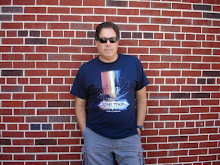Sunday, March 24, 2019
THIRD MAN, THE
(February 1950, U.S.)
The first thing you have to ask yourself when watching Carol Reed's THE THIRD MAN is, are we truly and honestly watching the work of Carol Reed or did Orson Welles himself step in as director of this British film noir? This was the speculation, and perhaps even misconception, over the years following the film's release. Too much of the film's style, editing, themes and overlapping dialogue seem to echo Welles's previous work. True or not, these sort of myths die hard. Does THE THIRD MAN remind you more of CITIZEN KANE or Reed's own NIGHT TRAIN TO MUNICH? Judge for yourself just how far Welles's influence went.
The film is set in post-World War II Vienna, Austria. Holly Martins (played by Joseph Cotten) is an American author of pulp-westerns who's just arrived in the city of ruins, having been offered a job by his friend Harry Lime (played by Orson Welles), only to discover upon his arrival that Harry is dead, a suspected victim of murder. Holly proceeds to meet with the people in Harry's life, including the British Army police inspectors, to investigate the suspicions surrounding his death. The impoverished, post-war city itself is a thriving environment of opportunistic racketeering divided into the American, British, French and Soviet sectors, as Holly soon discovers during his investigations. He eventually learns that his beloved friend Harry was, in fact, a criminal, and is pressured by the police to leave the city rather than take his inquiries any further. Refusing to leave town, Holly also befriends Harry's girlfriend Anna Schmidt (played by Alida Vallie), who's also an actress. Anna is the first one to suggest that Harry's death was not accidental. It seems that as soon as Harry was killed by a car, he was immediately carried off the street by someone else in addition to the two friends who were reportedly - a third man. For a time, Holly himself is suspected by the townspeople as being that third man.
Still refusing to leave Vienna, Holly finally learns from the police that Harry had been stealing large quantities of penicillin from military hospitals, diluting it, and then selling in on the black market for a high profit. As a result of the dilution, many patients died and many children were left brain damaged for life. The mounting and undeniable evidence finally convinces Holly of just who Harry really was, and finally agrees to leave town, disillusioned. Now drawn to Anna himself, Holly prepares to say goodbye, but is delayed when he thinks he notices someone strange and suspicious standing in a dark doorway. Through the camera's use of light and darkness, a resident's lit window briefly reveals the person to be Harry Lime himself. This is a rather important visual moment in the film, because it not only reveals the truth, but it also reveals the visual charm and wit that can only be evident in the smile of Orson Welles himself. That moment is only very brief before Harry is off and running into the city sewers. The British police immediately exhume Harry's buried coffin to discover that the body is that of an orderly who stole penicillin for Harry and was reported missing after turning informant.
The two old friend eventually meet in secret as they the Wiener Riesenrad, Vienna's Ferris wheel. Harry proceeds into a lengthy monologue (told with that irresistible Orson Welles charm) on the insignificance of his penicillin victims, revealing the full extent of criminal activity and his lack of morality. Realizing he can't convince Holly to see his side of things, Harry takes off again, and is soon beneath the bowels of the underground sewer system. Trying to escape the police who are hot on his trail, he's eventually shot and killed. The final resolution of the film is left with a sense of ambiguity, as Holly attempts to speak to a twice-heartbroken Anna at the cemetery, but is only left with her walking past him and fading into the unknown distance.
Cinematographer Robert Krasker's use of harsh lighting, as well as a distorted "Dutch angle" camera lens technique gives this classic black and white film an enriched, atmospheric form of expressionism. Its post-war seedy locations, iconic theme music on the zither by Viennese composer Anton Karas and solid performances by its players, give THE THIRD MAN the effective atmosphere of a city that's not only exhausted by war, but also insecure, cynical, and even criminal in the way it conducts its every day life and routines just at the time the Cold War is beginning. Indeed, the city of Vienna may be seen as a tragedy that must confront its troubled existence. It's look, its subtle physical details, and its plot twists and turns may be easily compared to some of Alfred Hitchcock's earlier works of the '40s. Whether we can ultimately credit Carol Reed or Orson Welles with the film's success, it's clear that THE THIRD MAN reveals itself as an intriguing cinematic package of story and camera tricks whose result may be on the cusp of pure genius. As noir, there's also that touch of mischievous and devilish humor told with darkness and depression that made the American style of filmmaking in the 1940s and 1950s so legendary...only this time, it's done by the British and a man like Orson Welles whose smile and charm may have been just one of the most villainous things we've ever seen in film...
Favorite line or dialogue:
Harry Lime: "Like the fella says, in Italy for thirty years under the Borgias, they had warfare, terror, murder, and bloodshed. But they produced Michelangelo, Leonardo da Vinci, and the Renaissance. In Switzerland, they had brotherly love, they had five hundred years of democracy and peace, and what did that produce? The cuckoo clock."
Subscribe to:
Post Comments (Atom)




No comments:
Post a Comment